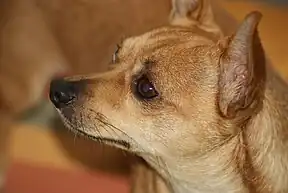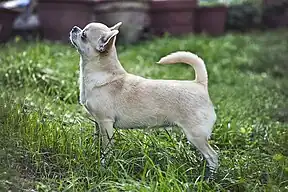| Chihuahua | |||||||||||||||||||||||||
|---|---|---|---|---|---|---|---|---|---|---|---|---|---|---|---|---|---|---|---|---|---|---|---|---|---|
 | |||||||||||||||||||||||||
| Other names | Chihuahueño | ||||||||||||||||||||||||
| Origin | Mexico | ||||||||||||||||||||||||
| |||||||||||||||||||||||||
| |||||||||||||||||||||||||
| Dog (domestic dog) | |||||||||||||||||||||||||
The Chihuahua[lower-alpha 1] (or Spanish: Chihuahueño) is a Mexican breed of toy dog. It is named for the Mexican state of Chihuahua and is among the smallest of all dog breeds.[3] It is usually kept as a companion animal or for showing.
History
DNA studies suggest that native American dogs entered North America from Siberia roughly 10,000 years ago, and were then isolated for some 9,000 years until the arrival of the first Europeans; these pre-contact dogs exhibited a unique genetic signature that is now almost gone.[4] A study based on sequencing of ancient dog genomes, published in 2020, suggests that this pre-colonial ancestry survives in two Mexican breeds, to the extent of about 4% in the Chihuahua (and some 3% in the Xoloitzcuintli).[5]
Colonial records refer to small, nearly hairless dogs at the beginning of the nineteenth century; one claims that sixteenth-century conquistadores found them plentiful in the region later known as Chihuahua.[6] In a letter written in 1520, Hernan Cortés wrote that the Aztecs raised and sold little dogs as food.[7]
The American Kennel Club first registered a Chihuahua in 1904, Midget, owned by H. Raynor of Texas.[8][9]
Characteristics
Chihuahuas are the smallest breed recognized by some kennel clubs.[10] Current breed standards defined by registries specify an "apple-head" or "apple-dome" skull conformation.[11] Chihuahuas occur in virtually any color combination, from solid to marked or splashed.[12] Apple-dome Chihuahuas have large, round eyes and large, erect ears, set in a high, dramatically rounded skull.[10] The stop is well defined, forming a near-90-degree angle where the muzzle meets the skull.[13] Dogs of the older "deer" type, with a flat-topped head, more widely set eyes, larger ears, and longer, more slender legs, may still be registered, but the deer head is not considered a separate type in competition and a deer-head dog's digression from the breed standard is considered a fault.[11][13]
Breed standards for this dog do not generally specify a height; only a weight and a description of their overall proportions. Generally, the height ranges between 6 and 9 in (15 and 23 cm);[10] however, some dogs grow as tall as 30 to 38 cm (12 to 15 in). Both British and American breed standards state that a Chihuahua must not weigh more than 5.9 lb (2.7 kg) for conformation.[10]
However, the British standard also states that a weight of 4–6 lb (1.8–2.7 kg) is preferred. A clause stating "if two dogs are equally good in type, the more diminutive one is preferred" was removed in 2009.[14] The Fédération Cynologique Internationale standard calls for dogs ideally between 1.5 and 3.0 kg (3.3 and 6.6 lbs), although smaller ones are acceptable in the show ring.[15]
Pet Chihuahuas (those bred or purchased as companions rather than as show dogs) often range above these weights, even above 10 lb (4.5 kg), if they have large bone structures or are allowed to become overweight.[10] This does not mean that they are not purebred Chihuahuas; they just do not meet the requirements to enter a conformation show. Oversized Chihuahuas are seen in some of the best, and worst, bloodlines. Chihuahuas do not breed true for size, and puppies from the same litter can mature in drastically different sizes from one another. Also, larger breeding females are less likely to experience dystocia (obstructed labor). Many breeders try to breed Chihuahuas to be as small as possible, because those marketed as "teacup" or "tiny teacup" demand higher prices.[16]
The Fédération Cynologique Internationale, which represents the major kennel clubs of 84 countries, disqualified the merle coat pattern, which appears mottled.[15] In May 2007, The Kennel Club decided not to register puppies with this coloration due to the health risks associated with the responsible gene, and in December of that year, formally amended its breed standard to disqualify merle dogs.[17]
Like many other small dogs, the Chihuahua may display above-average aggression toward people and other dogs.[18][19]

Health
The Chihuahua has some genetic predisposition to several neurological diseases, among them atlantoaxial instability, ceroid lipofuscinosis, congenital deafness, congenital hydrocephalus, muscular dystrophy, necrotizing meningoencephalitis, and neuroaxonal dystrophy;[20]: 3 [21] it has a mild predisposition to congenital heart disease.[22]: 478 In a radiographical study of canine periodontal disease in 2001, the Chihuahua was found to have the lowest incidence of the six breeds studied.[23]: 206 [24]: 532 The predisposition to medial patellar luxation is believed to be significant.[25]: 46
A Chihuahua may be expected to live for twelve years or more.[1]: 276
See also
- List of dog breeds
- Ren Hoek from Nickelodeon's The Ren & Stimpy Show
- Beverly Hills Chihuahua
- Chihuahua (state)
Notes
- ↑ Pronounced: /tʃɪˈwɑːwə, -wɑː, -ˈwaʊ.ə/ ⓘ[lower-alpha 2]
- Wells, John (April 3, 2008). Longman Pronunciation Dictionary (3rd ed.). Pearson Longman. ISBN 978-1-4058-8118-0.
References
- 1 2 3 4 Kim Dennis-Bryan (2020 [2012])). The Complete Dog Breed Book, second edition. London: Dorling Kindersley. ISBN 9780241412732.
- ↑ FCI-Standard N° 218: Chihuahueño (Chihuahua). Fédération Cynologique Internationale. Accessed October 2022.
- ↑ "The 25 Smallest Dog Breeds". American Kennel Club. Retrieved January 26, 2021.
- ↑ Ní Leathlobhair, Máire; et al. (July 6, 2018). "The evolutionary history of dogs in the Americas". Science. 361 (6397): 81–85. Bibcode:2018Sci...361...81N. doi:10.1126/science.aao4776. PMC 7116273. PMID 29976825. S2CID 206663458.
- ↑ Bergström, Anders; et al. (2020). "Origins and genetic legacy of prehistoric dogs". Science. 370 (6516): 557–564. doi:10.1126/science.aba9572. PMC 7116352. PMID 33122379. S2CID 225956269.
- ↑ Pedro Baptista Pino y Juan Lopez Cancelada, Exposición sucinta y sencilla de la Provincia del Nuevo México y otros escritos. Ed. Jesus Paniagua Perez. Valladolid: Junta de Castilla / León: Universidad de León, 2007, p. 244: "even in the desert the tiny dogs could be found, hunting rats, mice, and lizards." The footnote that follows alludes to starving Conquistadores reportedly hunting and stewing the dogs (Universidad Veracruzana, Arquivo Viejo, XXVI.2711).
- ↑ "Hernan Cortés: from Second Letter to Charles V, 1520". Fordham University. Archived from the original on August 23, 2014. Retrieved March 25, 2014.
- ↑ Coile, C. (2013). Chihuahuas: Everything about purchase, care, nutrition, behavior, and training. Hauppauge, NY: Barron's Educational Series, p. 7: "Only in 1904 did the American Kennel Club (AKC) register its first Chihuahua; a total of five were registered that year."
- ↑ "Chihuahua History: From Aztec Treasure to Popular Companion". American Kennel Club. January 6, 2022. Retrieved September 28, 2022.
- 1 2 3 4 5 Charlotte Wilcox (April 1, 1999). "Quick Facts". The Chihuahua. Capstone. pp. 4–5. ISBN 978-0-7368-0158-4. Retrieved March 1, 2013.
- 1 2 Walker, Joan Hustace (2006). The Everything Chihuahua Book: A Complete Guide to Raising, Training, And Caring for Your Chihuahua. Adams Media. pp. 16–18. ISBN 9781440523687. Retrieved June 15, 2019.
- ↑ American Kennel Club Chihuahua page, retrieved on July 29, 2007.
- 1 2 "Official Standard of the Chihuahua" (PDF). Retrieved November 12, 2019.
- ↑ "The Kennel Club". thekennelclub.org.uk. Archived from the original on October 30, 2017. Retrieved October 17, 2013.
- 1 2 "Chihuahua standard" (PDF). Fédération Cynologique Internationale. July 28, 2009. Retrieved October 25, 2011.
- ↑ Segovia, Stacey Smith (March 21, 2004). "Runt of the litter". The Leaf Chronicle. ProQuest 441596979.
- ↑ "Kennel Club breed standard". Thekennelclub.org.uk. May 15, 2006. Archived from the original on January 3, 2009. Retrieved August 14, 2009.
- ↑ Deborah L. Duffy, Yuying Hsu, James A. Serpell (2008). Breed differences in canine aggression. Applied Animal Behaviour Science. 114 (3–4, December 2008): 441–460. doi:10.1016/j.applanim.2008.04.006. (subscription required).
- ↑ Paul D. McGreevy, Dana Georgevsky, Johanna Carrasco, Michael Valenzuela, Deborah L. Duffy, James A. Serpell (December 2013). Dog Behavior Co-Varies with Height, Bodyweight and Skull Shape. PlosOne. doi:10.1371/journal.pone.0080529.
- ↑ Curtis W. Dewey, Ronaldo C. Da Costa (2016). Signalment and History: The First Considerations. In: Curtis W. Dewey, Ronaldo C. Da Costa (2016). Practical Guide to Canine and Feline Neurology, third edition. Ames, Iowa; Chichester, West Sussex; Oxford: Wiley Blackwell. ISBN 9781119946113, pages 1–8.
- ↑ Chihuahua (long and smooth coat): Hydrocephalus. Genetic Welfare Problems of Companion Animals. Wheathampstead, Hertfordshire: The International Animal Welfare Science Society/Universities Federation for Animal Welfare. Accessed February 2021.
- ↑ P. Oliveira, O. Domenech, J. Silva, S. Vannini, R. Bussadori, C. Bussadori (2011). Retrospective Review of Congenital Heart Disease in 976 Dogs. Journal of Veterinary Internal Medicine. 25: 477-483. doi:10.1111/j.1939-1676.2011.0711.x.
- ↑ V. Butković, M. Šimpraga, M. Šehić, et al. (2001) Dental diseases of dogs: a retrospective study of radiological data. Acta Veterinaria Brno. 70: 203–208.
- ↑ C. Wallis, L. J. Holcombe (2020). A review of the frequency and impact of periodontal disease in dogs. Journal of Small Animal Practice. 61: 529–540. doi:10.1111/jsap.13218.
- ↑ Alex Gough, Alison Thomas (2004). Breed Predispositions to Disease in Dogs and Cats. Oxford: Blackwell Publishing. ISBN 9781405107488.

